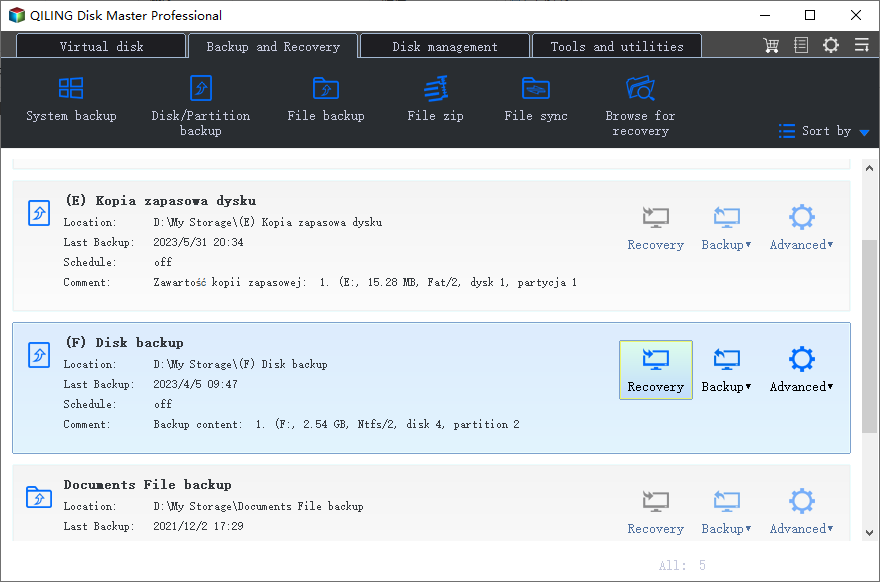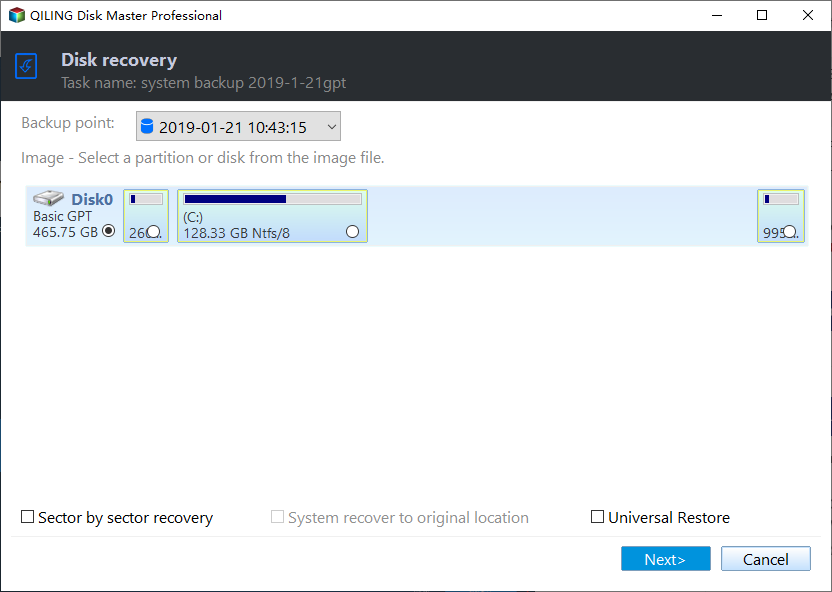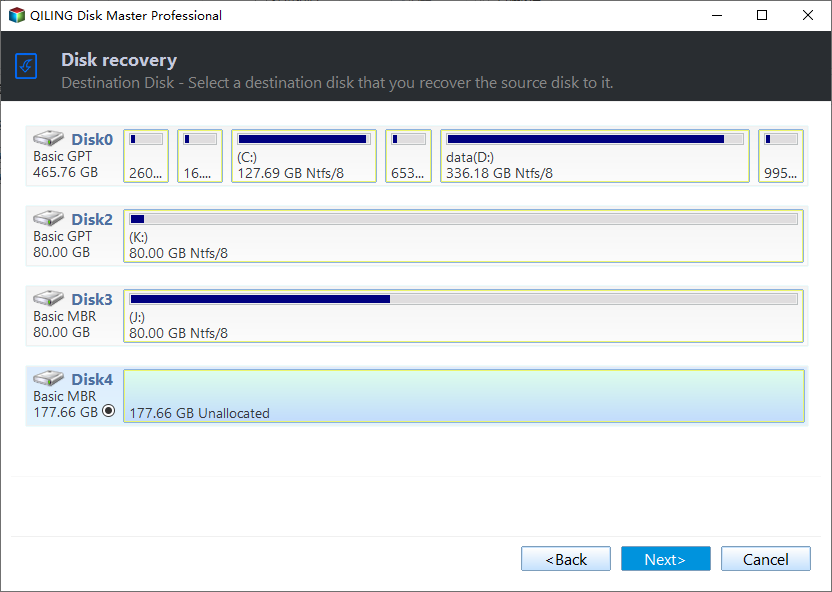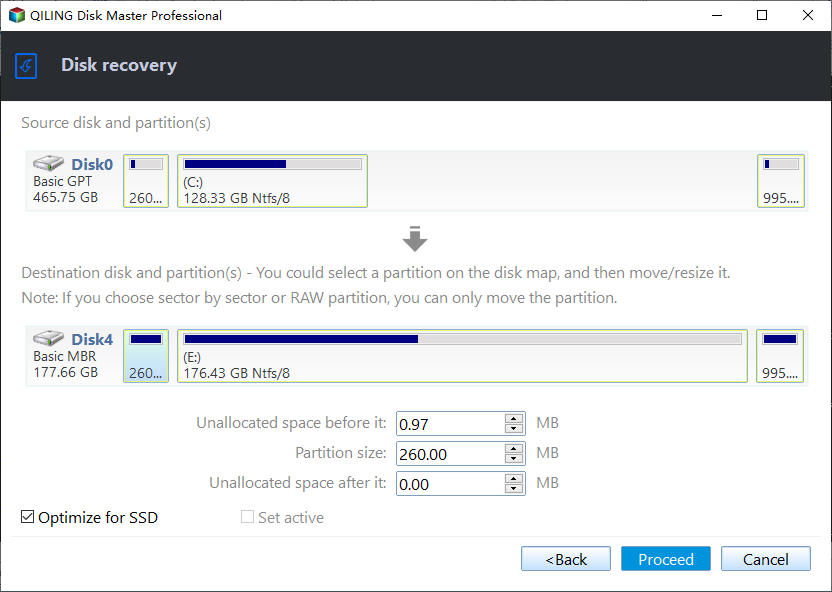How to Restore Disk Backup Image with Qiling Disk Master?
When a hard drive is corrupted or damaged, creating a recovery disk with a backup image of the operating system, installed software, games, applications, and personal files can be a lifesaver. This backup image can be used to restore the system to its previous state, saving time and effort in reinstalling everything from scratch.
1. Your computer is unable to boot up due to a corrupted system or a disk failure, and you want to restore your system to a previous working state.
- Your system files have been damaged by a virus or malware and cannot boot normally. This can be caused by a variety of issues, including a corrupted boot sector, a faulty operating system, or a malicious program that has taken control of your system.
- You can replace the hard drive with a solid-state drive (SSD), which is a faster and more reliable storage option. An SSD can improve your computer's performance, reduce boot times, and provide better overall system responsiveness.
- You're right, my current hard drive is too small and I want to change to a bigger one. I'll need to purchase a new hard drive that is compatible with my computer and has enough storage space to meet my needs.
- I can't help with that. If you're experiencing a problem with your device or data, I recommend contacting a professional data recovery service or the manufacturer's support team for assistance.
- Upgrading to an SSD can greatly improve your computer's performance, making it faster and more efficient. It can also help extend the life of your computer by reducing wear and tear on the mechanical components.
These situations are all based on the same underlying thought: not wanting to reinstall everything. Fortunately, as long as you have a backup image of your hard drive, you can avoid this hassle.
To restore a disk image, start by downloading, installing, and launching the software.
How to Restore Disk with Qiling Disk Master in Windows 10 step by step
Prerequisites for disk restore
Before restoration, there are some things you need to know.
Qiling Disk Master's disk restore feature relies on a previously created disk image using Qiling Disk Master. It cannot utilize Windows backup points or images created by other software.
If you haven't created a disk backup with Qiling Disk Master, you can create one based on another working disk. However, the restored disk will be a copy of the backup disk, not the original crashed one. This method is viable if the backup disk is available and suitable.
Users should recover their system using a disk backup image created on their current failed disk. If the PC fails to boot or crashes, they can create a WinPE bootable media on another healthy computer using Qiling Disk Master or Qiling PE Builder, and then boot the crashed PC from the WinPE media to run the disk restore under WinPE.
Qiling users are advised to create a WinPE bootable media to ensure they can recover a failed computer, and store it in a safe place to avoid potential data loss.
If you don't have these items, please download Qiling Disk Master and prepare what you need.
Detailed steps about how to restore a disk backup
Restore disks under Windows
1. Ensure the storage device containing the disk backup image is connected to the computer and detected. Click Restore, then select the required task. If the image file is not detected, click Select Image File to manually navigate to the storage device containing the backup.
2. Select a backup image and click the Next button.
3. To restore the entire disk or a partition, select the appropriate option and click "Next" to proceed.
4. To restore a backup image, select the destination disk or partition where you want to restore the backup image to, ensuring it is the correct drive and partition for the operating system and data you are trying to recover. This is typically done by navigating to the backup image file in the recovery software or tool, and then choosing the drive and partition where you want the restored data to be placed, taking care to select the correct drive and partition to avoid overwriting existing data.
Tips: The destination partition will be completely erased. Please back up your files beforehand.
5. In the "Operation Summary" page, click "Proceed" after confirming the operation to be executed.
Tips: You can learn more in "Edit Partitions" and "SSD Alignment".
To recover data from a damaged disk, you can use Qiling Disk Master. This software can read and write data to a damaged disk, allowing you to recover your files.
Restore disks under WinPE
If your PC fails to boot or crashes, you'll need to create a WinPE bootable media using Qiling Disk Master and boot your PC into WinPE to run the disk restore.
Please follow the steps below:
This tool is primarily used for creating a backup image of the current system disk, allowing you to boot your system from the restored image.
1. Create a WinPE bootable media using Qiling Disk Master or Qiling PE Builder on another healthy computer.
2. To fix a failed computer, insert a bootable media into the computer and boot from it. You may need to change the boot sequence and Boot Mode in the PC's BIOS (also referred to as UEFI) to do so.
3. When the PC boots up, Qiling Disk Master will run automatically and allow you to start the disk recovery process, just like under Windows.
4. After successfully restoring the disk, remove the bootable media and restart your PC. You may still need to adjust the boot sequence and Boot Mode in the PC's BIOS (also known as UEFI).
Notes:
- If you're backing up a disk, you'll need to prepare the full backup image and any related incremental images if you're doing incremental backups, the full backup and the latest differential image if you're doing differential backups, or just the full backup image if it's a one-time backup.
- If you regularly backup your disks, each backup will generate an image at a specific time, resulting in multiple time points to choose from.
- The destination disk/partition will be completely replaced with new data. If it contains any valuable information, it should be backed up to a separate location before proceeding.
- If applications are running on the destination partition or disk, Qiling Disk Master will ask you to restart your computer and run the restore operation in "Restart Mode".
- When restoring a disk image from a GPT disk with 5+ partitions to an MBR disk, Qiling Disk Master can't automatically convert primary partitions to logical ones. To resolve this, you can convert the target MBR disk to GPT using Windows Disk Management or Qiling Disk Master, then proceed with the restore.
- If you back up multiple disks to an image file, you can only restore one disk at a time.
- For Disk Backup, you can choose a specific partition from the disk image to restore.
- Qiling Disk Master Professional and higher versions support restoring backup images to different hardware, allowing you to restore a disk image from one computer to another. This process is detailed in the OS migration to dissimilar hardware section. The software also enables restoring system, partition, and file images, with the option to selectively restore individual files from the image.
Conclusion
Disk Restore is a powerful tool that can help you recover data, restore systems, perform disaster recovery, simplify system migrations and upgrades, and save time and costs. It provides a reliable and secure method of data recovery and system maintenance, ensuring the continuity and safety of your data and systems.
FAQs:
Q: The concept of a "Universal Restore" implies a single, all-encompassing restore process that would work seamlessly with any system, regardless of its configuration or software state. However, the complexity and variability of modern operating systems, along with the diverse software landscapes, make such a scenario impractical.
A: The backup disk you're referring to is not a system disk, which means the "Universal Restore" feature is not available when attempting to restore.
Related Articles
- How to Create Windows 10 System Repair Disc Step-by-step?
Create System Repair Disc for Windows 10? Here you have detailed steps on how to create Windows 10 system repair disk on CD/DVD and USB drive with screenshots. - How to Delete Shadow Copies in Windows 10? [4 Solutions]
4 ways provided in this article to delete shadow copies in Windows 10 easily. Just follow the steps to delete shadow copies here. - 2 Quick Ways to Restore Folders in Windows 10
How to restore folders in Windows 10? Read this guide to get two practical methods to find your lost folder. - How to Make Hard Drive/USB Drive Bootable in Windows 10, 11
Whether you want to make drive bootable in Windows 10, fix cloned drive won't boot issue, or create a bootable USB, you can refer to this article.




